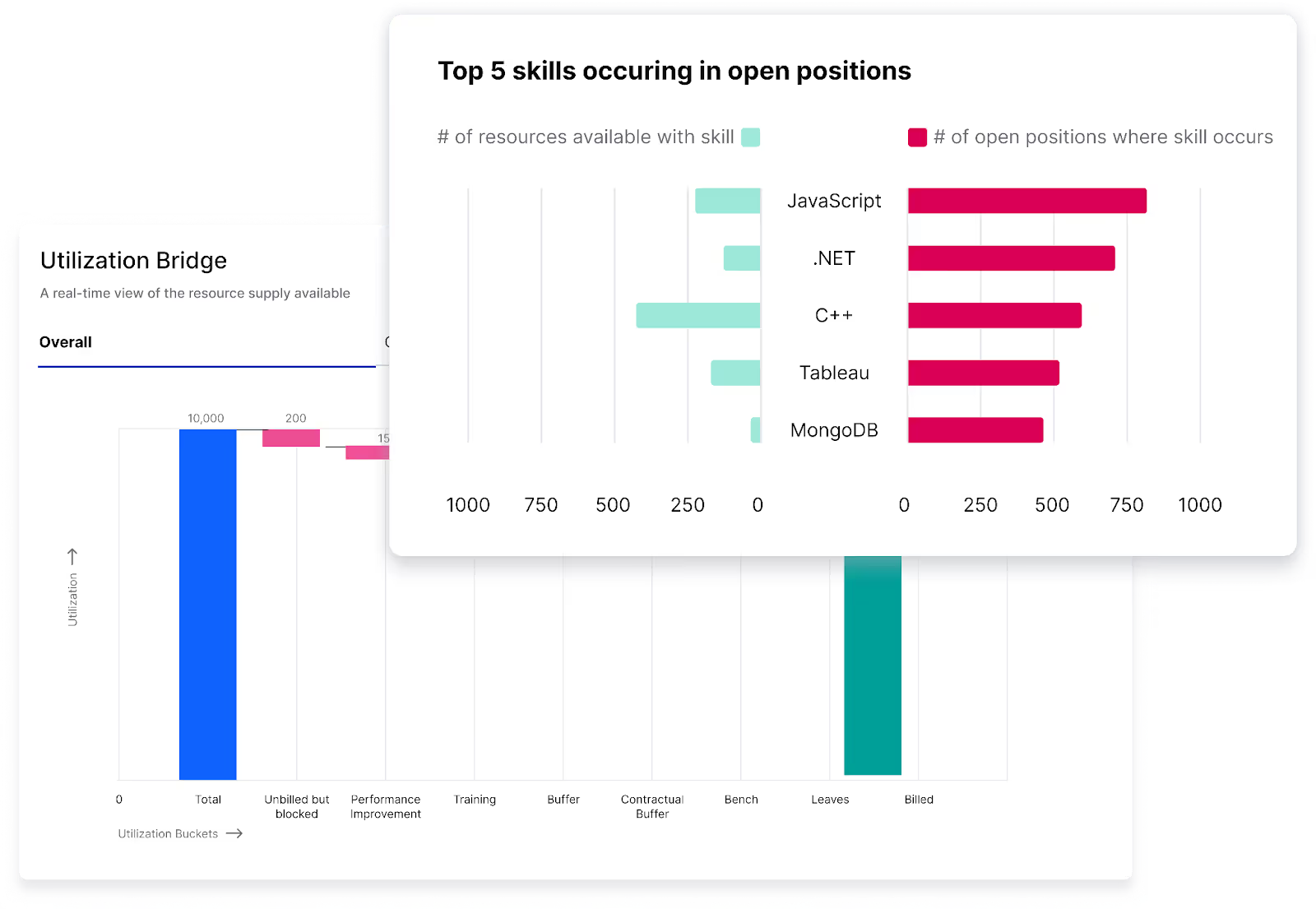
What if we told you that the secret to scaling your organization’s success isn’t just about hiring the right people—it’s about building a system that ensures the right talent is in the right place at the right time, every time?
Today, talent isn’t just a resource; it’s the lifeblood of innovation, growth, and operational excellence. Yet, most organizations still treat talent acquisition and management as a reactive, piecemeal process. They scramble to fill roles when vacancies arise, struggle with skill gaps, and often find themselves overpaying for underqualified talent. Sound familiar? Consider the fact that in July 2022, 5.2% of job postings had advertised signing bonuses, which was a jump of 3 times from the same month in 2019!!
But what if you could flip the script? What if you could predict your talent needs, align them with your business goals, and create a seamless flow of skills and expertise—just like a well-oiled supply chain? That’s where the Talent Supply Chain Strategy comes in.
At Prismforce, we’ve spent years helping organizations transform their talent management from a chaotic scramble into a strategic advantage. And in this post, I’m going to show you exactly how to implement a Talent Supply Chain Strategy that not only solves your talent woes but also positions your organization for sustainable growth.
Whether you’re a startup scaling at lightning speed or an enterprise navigating complex workforce dynamics, this is your playbook for building a talent engine that delivers—every single time. Let’s dive in.
Why Implementing a Talent Supply Chain Strategy is Crucial
The implementation of a talent supply chain strategy offers numerous benefits to organizations, particularly in the tech industry:
- Improved Workforce Planning: By anticipating future skill requirements and aligning them with business goals, companies can proactively address talent gaps and avoid costly shortages.
- Enhanced Talent Acquisition: A strategic approach to talent sourcing enables organizations to tap into diverse talent pools and build relationships with potential candidates before needs arise.
- Increased Agility: A well-managed talent supply chain allows companies to quickly adapt to changing market conditions and technological advancements by having the right skills available at the right time.
- Cost Optimization: By streamlining recruitment processes and reducing time-to-hire, organizations can significantly lower their talent acquisition costs and improve overall workforce efficiency.
- Competitive Advantage: Companies with robust talent supply chains are better positioned to innovate, respond to market demands, and outperform competitors who struggle with talent shortages.
Given these advantages, it's clear that implementing a talent supply chain strategy is no longer optional for organizations aiming to thrive in the tech industry. The following sections will outline key steps to help companies successfully implement this crucial strategy.
How to Implement Talent Supply Chain Strategy? Key Steps
Establish a Resourcing Strategy
The first step in implementing a talent supply chain strategy is to develop a comprehensive resourcing strategy. This involves:
- Assessing Current Workforce: Conduct a thorough analysis of existing skills, competencies, and gaps within the organization.
- Defining Future Skill Requirements: Identify the skills and expertise needed to support long-term business objectives and technological advancements.
- Determining Sourcing Channels: Evaluate various talent acquisition methods, including internal talent development, external hiring, and partnerships with educational institutions or talent providers.
- Creating Role Profiles: Develop detailed descriptions of key positions, including required skills, experience, and cultural fit.
- Establishing Metrics: Define key performance indicators (KPIs) to measure the effectiveness of the resourcing strategy.
By establishing a clear resourcing strategy, organizations can lay the foundation for a successful talent supply chain implementation.
Anticipate and Target Future Demand
To ensure a steady flow of talent, companies must develop the ability to anticipate and target future demand. This involves:
- Workforce Planning: Utilize data analytics and predictive modeling to forecast future talent needs based on business growth projections, technological trends, and market dynamics.
- Skills Gap Analysis: Regularly assess the skill gap between current workforce capabilities and future skill requirements to identify areas for development or acquisition.
- Talent Mapping: Create a visual representation of the organization's talent landscape, highlighting critical roles, potential successors, and areas of risk.
- Scenario Planning: Develop multiple talent scenarios based on different business outcomes to ensure preparedness for various future states.
- Collaboration with Business Units: Work closely with department heads and project managers to understand upcoming initiatives and their talent implications.
By proactively anticipating future talent needs, organizations can avoid last-minute scrambles for critical skills and maintain a competitive edge in the market.
Align People, Processes, and Technology
Successful implementation of a talent supply chain strategy requires seamless alignment of people, processes, and technology. This involves:
- Cross-functional Collaboration: Foster cooperation between HR, recruitment, and business units to ensure a holistic approach to talent management.
- Process Optimization: Streamline recruitment, onboarding, and talent development processes to enhance efficiency and reduce time-to-productivity.
- Technology Integration: Implement integrated HR systems that support talent acquisition, performance management, and workforce planning.
- Data-driven Decision Making: Leverage analytics tools to gain insights into talent trends, workforce performance, and skill gaps.
- Change Management: Develop a comprehensive change management plan to support the adoption of new processes and technologies across the organization.
By aligning these key elements, organizations can create a cohesive talent supply chain that effectively supports business objectives.
Leverage Analytics to Track and Measure Impact
To ensure the success of a talent supply chain strategy, organizations must leverage analytics to track and measure its impact. This includes:
- Establishing Key Metrics: Define relevant KPIs such as time-to-hire, cost-per-hire, quality of hire, and employee retention rates.
- Implementing Dashboards: Create visual dashboards that provide real-time insights into talent supply chain performance and trends.

- Conducting Regular Audits: Perform periodic assessments of the talent supply chain to identify areas for improvement and optimization.
- Predictive Analytics: Utilize advanced analytics to forecast future talent needs and potential risks in the supply chain.
- ROI Analysis: Measure the return on investment of talent supply chain initiatives to demonstrate value to stakeholders.
By leveraging analytics, organizations can continuously refine their talent supply chain strategy and demonstrate its impact on business outcomes.
Develop Partnerships to Expand Talent Pools
Expanding talent pools is crucial for maintaining a robust talent supply chain. Organizations should focus on developing strategic partnerships to achieve this:
- Educational Institutions: Collaborate with universities and technical schools to create tailored programs that align with future skill needs.
- Industry Associations: Engage with professional associations to tap into specialized talent networks and stay informed about industry trends.
- Talent Marketplaces: Partner with online talent platforms and gig economy talent marketplaces to access a diverse range of skills on-demand.
- Competitor Collaborations: Explore opportunities for cross-industry talent exchanges or joint development programs with non-competing organizations.
- Global Talent Networks: Establish connections with international talent pools to access specialized skills that may be scarce locally.
By cultivating these partnerships, organizations can ensure a diverse and sustainable pipeline of talent to support their long-term growth objectives.
Foster a Culture of Continuous Learning
To maintain a competitive edge in the fast-paced tech industry, organizations must foster a culture of continuous learning within their talent supply chain:
- Learning and Development Programs: Implement comprehensive training initiatives that address both current and future skill requirements.
- Mentorship and Coaching: Establish mentorship programs that facilitate knowledge transfer between experienced employees and new talent.
- Cross-functional Rotations: Encourage employees to gain diverse experiences through cross-functional assignments and job rotations.
- Innovation Labs: Create dedicated spaces for employees to experiment with new technologies and develop innovative solutions.
- Continuous Feedback: Implement regular feedback mechanisms to support ongoing skill development and performance improvement.
By prioritizing continuous learning, organizations can ensure that their talent supply chain remains adaptive and resilient in the face of technological change.
Overcoming Challenges in Talent Supply Chain Implementation
While implementing a talent supply chain strategy offers numerous benefits, organizations may encounter several challenges along the way:
Resistance to Change
Change management is a critical aspect of implementing a new talent supply chain strategy. To overcome resistance:
- Communication: Develop a clear communication plan that articulates the benefits of the new strategy to all stakeholders.
- Involvement: Engage key personnel in the planning and implementation process to foster a sense of ownership.
- Training: Provide comprehensive training to ensure that all employees understand and can effectively use new processes and tools.
- Gradual Implementation: Consider a phased approach to implementation, allowing time for adjustment and feedback at each stage.
- Leadership Support: Secure visible support from top management to reinforce the importance of the initiative.
Lack of Skilled Resources
Implementing a talent supply chain strategy often requires specialized skills that may not be readily available within the organization:
- Upskilling Existing Staff: Invest in training programs to develop the necessary skills within the current workforce.
- External Hiring: Recruit specialists with experience in talent supply chain management to lead the implementation.
- Consultancy Support: Engage external consultants to provide expertise and guidance during the initial stages of implementation.
- Partnerships: Collaborate with technology vendors or HR service providers to access specialized skills and resources.
- Cross-functional Teams: Form teams that combine existing organizational knowledge with new talent supply chain expertise.
Integration with Existing Processes
Integrating a new talent supply chain strategy with existing HR and business processes can be challenging:
- Process Mapping: Conduct a thorough analysis of current processes to identify areas of overlap or potential conflict.
- Stakeholder Alignment: Work closely with all affected departments to ensure seamless integration and minimal disruption.
- System Integration: Invest in technology solutions that can integrate with existing HR and ERP systems.
- Pilot Programs: Test the new strategy in specific departments or projects before full-scale implementation.
- Continuous Improvement: Establish feedback loops to identify and address integration issues as they arise.
Measuring and Monitoring Performance
Effectively measuring and monitoring the performance of a talent supply chain strategy is crucial for its long-term success:
- Establish Baselines: Define clear baseline metrics before implementation to accurately measure improvements.
- Customized Metrics: Develop KPIs that align with specific organizational goals and industry benchmarks.
- Regular Reporting: Implement a structured reporting system to track progress and identify areas for improvement.
- Data Quality: Ensure the accuracy and reliability of data used for performance measurement.
- Continuous Refinement: Regularly review and adjust performance metrics to reflect changing business needs and market conditions.
By proactively addressing these challenges, organizations can significantly increase their chances of successfully implementing and maintaining an effective talent supply chain strategy
Implement Talent Supply Chain Strategy with Prismforce and Build a Strong Talent Pipeline
As organizations navigate the complexities of implementing a talent supply chain strategy, leveraging advanced tools and platforms can significantly enhance their chances of success. Prismforce offers a comprehensive solution designed specifically for the tech industry, enabling companies to build and maintain a robust talent pipeline.Prismforce's AI-powered platform provides:
- Advanced Analytics: Gain deep insights into your workforce composition, skills inventory, and future talent needs.
- Demand Forecasting: Utilize predictive modeling to anticipate future skill requirements based on industry trends and business projections.
- Talent Marketplace: Access a vast network of skilled professionals to quickly fill critical roles and address skill gaps.
- Skill Development Tracking: Monitor and manage employee skill development to ensure alignment with organizational needs.
- Performance Optimization: Leverage data-driven insights to optimize talent allocation and improve overall workforce productivity.
By partnering with Prismforce, organizations can accelerate their talent supply chain strategy implementation and gain a competitive edge in the tech talent market.





